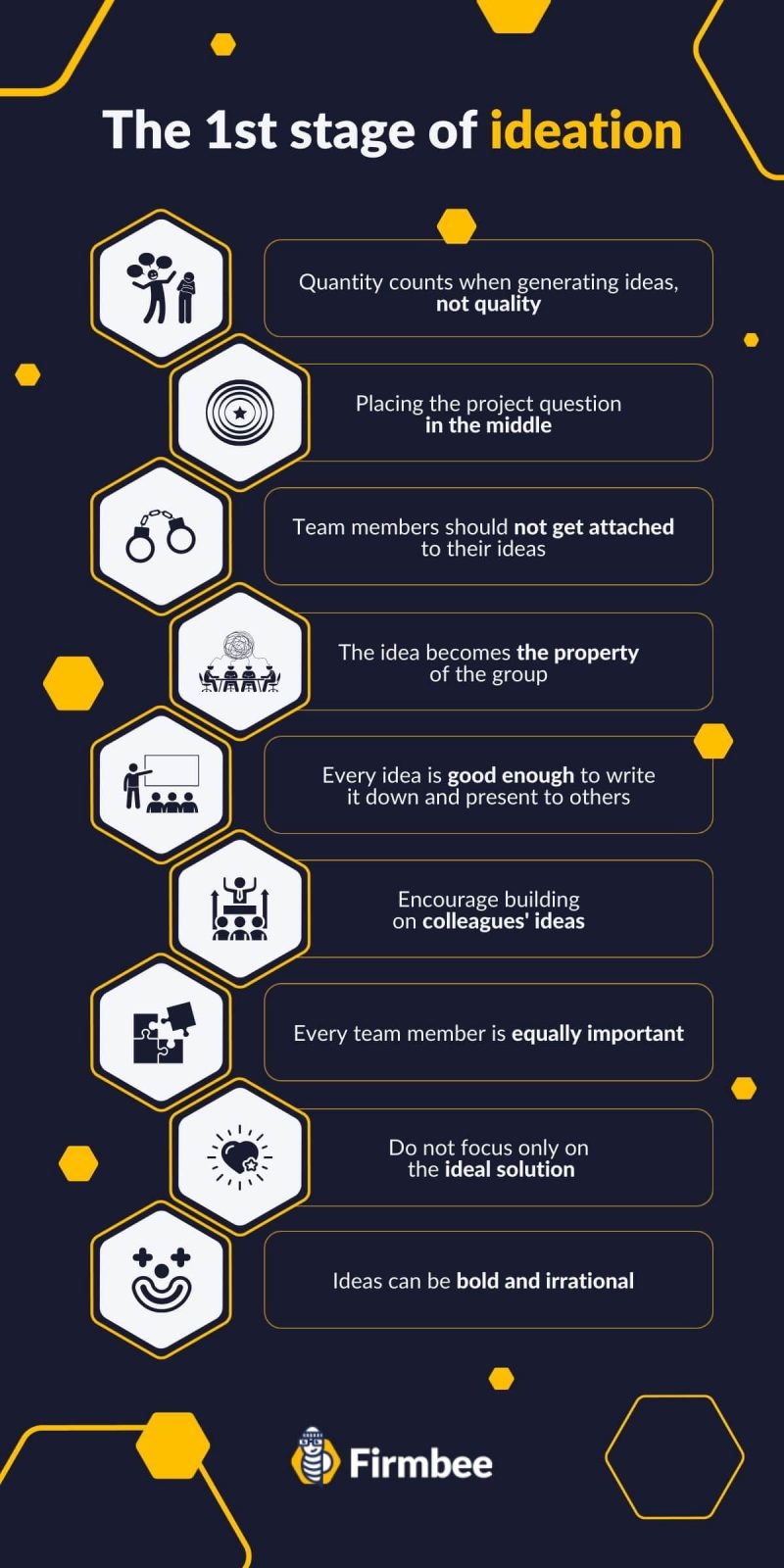Everyone occasionally experiences a feeling of a blank mind. It may have happened during a decisive situation and it would have made a difference if you had an idea of what to say. Thus, what to do in such situations when there are no ideas to solve the problem? To the rescue in such circumstances comes ideation- a stage in the process called design thinking. This is not only the most anticipated phase by researchers but also the most creative one. Not only in professional life but also in everyday life.
Ideation stage – table of content:

The 1st stage of ideation
The stages of empathizing and defining the problem have already been discussed in previous articles. Once the problem has been properly defined, it is time for the most creative part of the whole process, i.e., ideation. Take into consideration that this stage is as time-consuming as the previous ones, but it enables the research team to freely express and share their ideas. Even though it is a very dynamic and rapidly changing part of the project, try to establish its hierarchy by focusing on the priorities to improve the workflow of the team. Also, get acquainted with the rules that should prevail during this phase:
- Quantity counts when generating ideas, not quality – the more the better
- Placing the project question in the middle – so that each researcher remembers what to focus on
- Team members should not get attached to their ideas
- The idea becomes the property of the group – after all the team works together
- Every idea is good enough to write it down and present to others
- Encourage building on colleagues’ ideas, developing them and creating new ones
- Every team member is equally important – thus every idea is equally valuable
- Do not focus only on the ideal solution
- Ideas can be bold and irrational
During this stage, we should focus on eliciting creative, spontaneous, and vivid suggestions from participants. To have such, we ought to take the responses of our research team with an open mind, refining from criticism while providing positive feedback to encourage everyone to speak out. What’s more, we should provide the group with undistracted space making sure no obstacles come in the way.
Tools for conceiving ideas
Like many ideas, as many creative tools. The most popular tool is “brainstorming”, while there are many variations of it. The most popular is the so-called “Silent brainstorm”.
- Silent brainstorming – a process in which each of the researchers generates ideas individually, to present them to the others. It requires keeping an eye on a specific amount of time in which to generate as many ideas as possible. When choosing a brainstorming method, several factors should be taken into account, such as the number of people in the team, whether there are dominant people in the team or the place where the study is performed.
- SCAMPER – is a method that involves improving existing solutions. The name of the technique is an acronym referring to the individual techniques (S-substitute, C-combine, A-adapt, M- modify, P – put to other uses, E – eliminate, R – reverse). Each of the mentioned techniques refers to a separate set of activities thus enabling us to get into the essence of the problem and modify the current solutions.
- Bionics – an idea based on generating ideas from natural phenomena. A source of inspiration is the use of bionics in technology, architecture, transportation, etc. when creating new concepts and ideas. The most renowned example is the Velcro fastener patented by George de Mestral, who got his inspiration during a walk when so-called “Velcro” (burdock fruit) stuck to his clothes (burdock fruit).
- Brainwriting 635 – This is an alternative to brainstorming. In the study, the group is divided into 6 people per team, each person has 5 minutes to write down 3 ideas that are the answer to the given issue. After the time is up, the participant passes their sheet to the next person who then writes their 3 ideas based on their previous answers. These can be completely new solutions or possible improvements to the previous idea. This is an instant method as it should take about 30 minutes and over 100 ideas are generated in that time.
- Ideal system concept– this is G. Nagler’s method in which at the outset the team formulates an ideal concept and then a system is gradually established to ultimately meet the ideal within a certain constraint. The function of the system in this case is the goal and the whole system should strive to achieve this function.
We ought to adjust the idea generation tools depending on the problem at hand. Thus, it is worthwhile to dig deeper into the purpose of the idea then draw inspiration from the available research methods.
Categorizing ideas in the ideation stage
Once all the ideas have been organized in one place it is time to categorize them. Ideally, they should be divided into four categories:
- Ideas to drop – these deviated significantly from the core of the problem or have already been tried but have not produced satisfactory results.
- Inspirational but crazy – at first seem impossible to implement but have hidden potential, so it’s worth saving them for the future.
- Quick shots – ideas that are slightly different from the existing ones but have a modification that can function in everyday life as an innovation.
- Ideas with potential – these are the ones the research team should care about the most. They are the ones that, with the use of existing technology and knowledge, allow the researchers to create target products tailored to the needs of the audience.
When selecting ideas, researchers should focus most on ideas with potential and those inspiring but crazy. These are the most valuable ones, and if they make it through the ideation stage, the team will develop them in the subsequent stages of the design thinking process. Also, what might help in selecting appropriate ideas if there are too many to chose from, or the team is not equivocal, is a decision matrix. In it, you can rank ideas in terms of relevance to the user and ease of implementation and objectively decide which innovations are worth pursuing.
If you like our content, join our busy bees community on Facebook and Twitter.
Author: Zofia Lipska
With over 10 years of experience in digital marketing, Sophia not only knows the rules of this industry but above all knows how to break them in order to achieve outstanding and creative results.


















